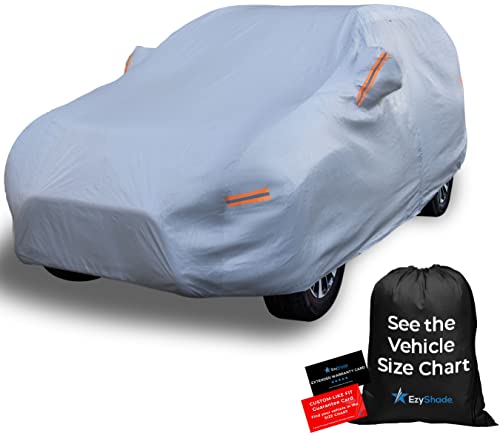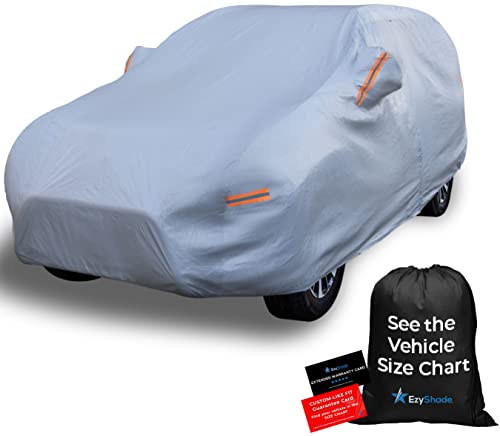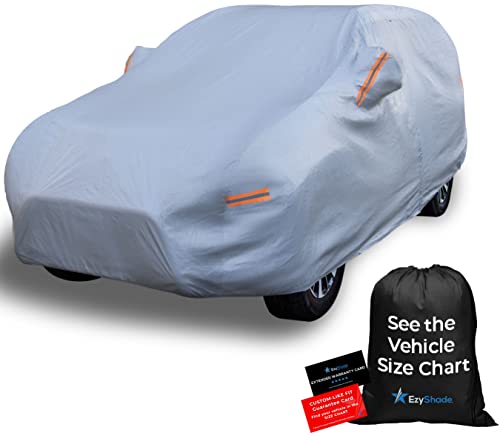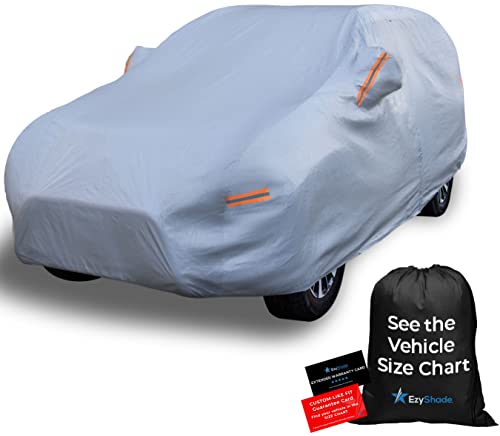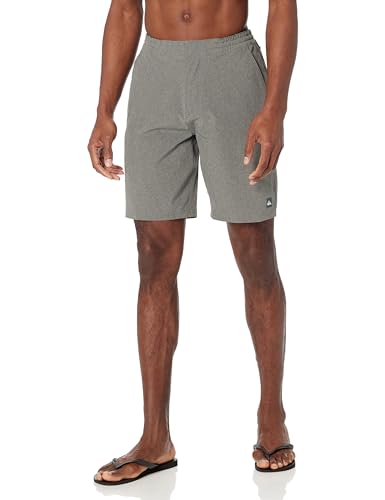Remember that family road trip where you squeezed everyone and all their luggage into a cramped minivan? This year, let’s make sure that doesn’t happen again! Finding the best large SUV 2025 is crucial for comfortable and safe travel for larger families or those who need ample cargo space. This guide will help you navigate the market and choose the perfect vehicle for your needs, saving you time and potentially thousands of dollars in the process. You’ll learn about features, compare models, and understand what makes a large SUV truly ‘best’ for you.
Key Takeaways
- Discover the top contenders for the best large SUV 2025.
- Compare features, safety ratings, and fuel efficiency across various models.
- Learn about essential considerations when choosing a large SUV.
- Understand the pros and cons of different drivetrains and engine options.
- Find the perfect large SUV to fit your budget and lifestyle.
Top Contenders for the Best Large SUV 2025
This section dives into the leading contenders for the title of best large SUV in 2025. We’ll analyze their key features, performance, and overall value to help you make an informed decision. We’ll cover aspects like passenger capacity, cargo space, safety features, and fuel efficiency. We also consider reliability based on industry reports and owner reviews.
Chevrolet Suburban
Known for its legendary spaciousness and powerful engine options, the Chevrolet Suburban is a long-standing favorite among large SUV buyers. Its rugged design and ample towing capacity make it suitable for both families and outdoor enthusiasts. The Suburban consistently ranks highly in customer satisfaction surveys. A key feature is its extensive technology suite, including advanced safety and infotainment systems.
- Exceptional passenger and cargo space: The Suburban’s vast interior comfortably seats up to nine passengers and offers ample cargo space, easily accommodating large families or significant luggage for long trips.
- Powerful engine options: Available with powerful V8 engines, the Suburban provides impressive towing capacity and smooth acceleration, essential for hauling heavy loads or navigating challenging terrains.
- Advanced safety features: The Suburban is equipped with a comprehensive suite of advanced safety features, such as automatic emergency braking, lane departure warning, and adaptive cruise control, ensuring the safety of passengers and other drivers on the road.
Ford Expedition
The Ford Expedition is another strong contender in the large SUV segment, offering a compelling combination of rugged capability, family-friendly features, and modern technology. It’s often praised for its off-road prowess and towing capability. We’ll delve into specifics to see how it stacks up against the competition.
- Robust build quality and off-road capabilities: The Expedition is known for its strong body-on-frame construction and available four-wheel drive, making it suitable for tackling rough terrains and towing heavy trailers.
- User-friendly infotainment system: Ford’s Sync system provides a seamless and intuitive user experience, making it easy to navigate the various features and controls of the vehicle.
- Competitive pricing and fuel efficiency: While large SUVs tend to be fuel-intensive, the Ford Expedition offers competitive fuel economy compared to some rivals in its class.
Toyota Sequoia
The Toyota Sequoia is renowned for its reliability and durability, making it a popular choice among buyers seeking a long-lasting and dependable large SUV. Toyota’s reputation for reliability is a major factor in its consistent popularity. We’ll examine the features that contribute to its enduring appeal.
- Exceptional reliability and longevity: Toyota’s reputation for building reliable vehicles translates to the Sequoia, which consistently receives high marks for its durability and longevity.
- Spacious and comfortable interior: The Sequoia provides a spacious and comfortable cabin for passengers, with ample legroom and headroom in all three rows of seating.
- Available advanced driver assistance features: The Sequoia comes equipped with a range of advanced driver assistance systems, designed to enhance safety and improve driving experience. Features such as adaptive cruise control and lane departure warning are frequently cited as positives.
Choosing the Right Best Large SUV 2025 for Your Needs
This section will guide you through the key considerations when selecting a large SUV. We’ll look beyond just the model name to consider your individual needs and preferences. Factors such as family size, cargo requirements, and budget will play a significant role in the decision-making process.
Passenger Capacity and Cargo Space
Families with multiple children will prioritize larger passenger capacity. Consider the number of regular passengers versus occasional passengers and the possibility of car seats. The cargo space should accommodate your family’s needs, including luggage, sporting equipment, or other items. Think about trips you take and how much space you’ll require regularly and occasionally.
- Measure your current luggage: Before heading to the dealership, carefully measure your family’s typical luggage and sporting equipment to ensure the chosen SUV can comfortably accommodate it. Don’t forget strollers and other bulky items.
- Consider third-row accessibility: If you frequently use the third-row seats, make sure they are easily accessible and comfortable for adults and children. Some SUVs have more convenient third-row access than others.
- Evaluate cargo floor versatility: Look for features such as adjustable cargo floors or foldable seats that maximize cargo space flexibility and allow you to adapt the interior to different needs.
Safety Features and Technology
Safety should be paramount. Check for advanced driver assistance systems (ADAS) like automatic emergency braking, lane-keeping assist, and adaptive cruise control. Examine safety ratings from organizations like the IIHS and NHTSA. Technology features like infotainment systems, smartphone integration, and navigation are also important considerations.
- Research safety ratings: Check the safety ratings of potential SUVs from independent organizations like the Insurance Institute for Highway Safety (IIHS) and the National Highway Traffic Safety Administration (NHTSA) before making a decision.
- Test drive the infotainment system: Spend time during your test drive exploring the infotainment system, making sure it is user-friendly and meets your needs. Consider features such as smartphone integration, navigation, and voice control.
- Assess the driver-assistance technologies: Test out the driver-assistance features, such as adaptive cruise control and lane-keeping assist, to see how well they function and if they meet your expectations.
Fuel Efficiency and Engine Performance
Large SUVs are not known for exceptional fuel economy, but there is variation amongst models. Consider the engine size and fuel type. Also consider towing capacity if you need to tow a boat, trailer, or other heavy equipment. Regular driving patterns should also influence this decision.
- Compare fuel economy ratings: Compare the EPA-estimated fuel economy ratings of different SUVs to identify models that offer better fuel efficiency than others in their class.
- Consider engine power and performance: Consider the engine’s horsepower and torque to assess its power and acceleration capabilities, especially if you frequently tow heavy loads or travel in hilly areas.
- Evaluate towing capacity: If you regularly need to tow a trailer, boat, or other heavy equipment, choose an SUV with a high towing capacity that meets your needs.
Comparative Analysis of Best Large SUVs 2025
Let’s compare some of the key aspects of the top contenders discussed earlier. This table will help to quickly visualize the key differences and similarities between these popular models. Remember that specific trim levels and options can affect these figures.
| Feature | Chevrolet Suburban | Ford Expedition | Toyota Sequoia |
|---|---|---|---|
| Passenger Capacity | Up to 9 | Up to 8 | Up to 8 |
| Cargo Space (behind 3rd row) | ~40 cubic feet | ~20 cubic feet | ~20 cubic feet |
| Towing Capacity (Max) | Up to 8,300 lbs | Up to 9,300 lbs | Up to 9,000 lbs |
| Starting Price (Estimate) | ~$55,000 | ~$50,000 | ~$53,000 |
| Fuel Economy (City/Highway) (Estimate) | 14/20 mpg | 17/23 mpg | 16/19 mpg |
Note: Prices and fuel economy figures are estimates and can vary based on trim level, engine, and options chosen. Always check the latest manufacturer specifications.
Debunking Common Myths about Large SUVs
Myth 1: All Large SUVs are Gas Guzzlers
While large SUVs generally consume more fuel than smaller vehicles, advancements in engine technology and fuel efficiency have led to significant improvements in recent years. Several models now offer better fuel economy than their predecessors, proving that fuel efficiency is improving in this class.
Myth 2: Large SUVs Are Difficult to Maneuver
While their larger size requires more attention when parking and navigating tight spaces, modern large SUVs often feature advanced driver assistance systems like parking assist and blind-spot monitoring. These features significantly ease maneuverability, making them surprisingly manageable in urban environments.
Myth 3: Large SUVs Lack Technological Advancements
Modern large SUVs are packed with advanced technology, including state-of-the-art infotainment systems, driver-assistance features, and safety technologies. This misconception is outdated, as many leading manufacturers prioritize tech integration in their large SUV models.
Real-Life Case Studies
A family of six, including four children, successfully used a Chevrolet Suburban for a cross-country road trip, comfortably fitting everyone and their luggage. They appreciated the ample passenger and cargo space, and the advanced safety features gave them peace of mind during their journey.
Another family, needing to haul their camping gear and a boat, opted for the Ford Expedition. Its high towing capacity and robust build made it ideal for their outdoor adventures. They praised the vehicle’s handling even with a heavy load.
A couple who frequently traveled to remote areas for their work chose the Toyota Sequoia, appreciating its reliability and off-road capabilities. The vehicle’s durability proved invaluable in several challenging situations.
Sample Scenarios and Step-by-Step Guide
- Scenario 1: Choosing a Large SUV for a Growing Family. Consider passenger capacity (number of children, car seats), cargo space (strollers, luggage), safety features (advanced driver-assistance systems), and budget.
- Scenario 2: Selecting an SUV for Towing. Prioritize towing capacity, engine power, and transmission type (towing package often recommended). Carefully consider the weight of what you regularly tow.
- Step 1: Define your needs and budget.
- Step 2: Research different models and compare specifications.
- Step 3: Test drive several SUVs to experience their handling and features.
- Step 4: Check safety ratings and reviews.
- Step 5: Make your final decision based on your priorities.
Frequently Asked Questions (FAQs)
What is the most reliable large SUV in 2025?
Based on industry data and customer reviews, Toyota models, such as the Sequoia, often rank highly in terms of reliability. However, the reliability of any vehicle can vary depending on maintenance and individual usage.
Which large SUV offers the best fuel economy?
While fuel economy in large SUVs is generally lower than in smaller vehicles, some models such as the Ford Expedition have made significant improvements. The actual fuel economy achieved will depend on driving style and conditions.
What are the best safety features to look for in a large SUV?
Prioritize features such as automatic emergency braking, lane-keeping assist, adaptive cruise control, blind-spot monitoring, and a high safety rating from organizations like IIHS and NHTSA.
How much does a large SUV typically cost?
The price of a large SUV varies considerably based on the brand, model, trim level, and options selected. Expect a price range starting from approximately $50,000 and extending upwards of $80,000 or more for fully loaded models.
What is the difference between a full-size SUV and a large SUV?
The terms are often used interchangeably. Generally, “full-size” refers to the largest category of SUVs, encompassing those like the Chevrolet Suburban, Ford Expedition, and Toyota Sequoia. “Large SUV” might encompass a slightly broader category, but the distinction isn’t strictly defined.
What are some common maintenance considerations for large SUVs?
Given their size and power, regular maintenance like oil changes, tire rotations, and brake inspections are crucial. Additionally, attention to the suspension system is often needed due to the vehicle’s weight.
Final Thoughts
Choosing the best large SUV 2025 is a significant decision. By carefully considering your individual needs and priorities, researching various models, and comparing their features, you can find the perfect vehicle to meet your family’s or business needs. Remember to test drive different models and make a decision based on what best fits your lifestyle. Don’t hesitate to revisit this guide as you continue your search for the perfect large SUV!

